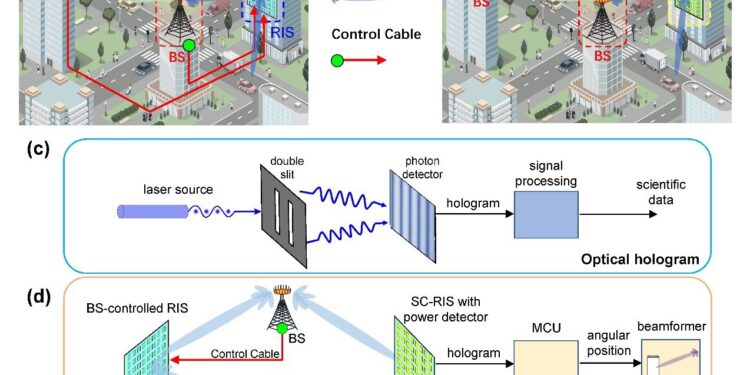Overall diagram of a self-controlled RIS of holographic inspiration. Credit: Credit: Zhu et al.
Reconfigurable smart surfaces (RIS) are technical structures composed of several elements called “meta-atoms”, which can reshape and control electromagnetic waves in real time. These surfaces could contribute to the advancement of wireless communication and location systems, as they could be used to reliably redirect, enhance and suppress signals.
In conventional applications of RIS for wireless communication, each meta-atom is controlled by a system called a “base station,” which is connected to the surface via electrical cables. Although surfaces following this design may achieve good results, their reliance on cables and a base station could prevent or limit their real-world deployment.
Researchers from Tsinghua University and Southeast University recently developed a new RIS that controls itself and does not need to be connected to a base station. This new surface, presented in an article published in Natural electronicsis inspired by holography, a well-known method for recording and reconstructing the light pattern of an object in order to produce a 3D image.
“We wanted to build a truly autonomous reconfigurable intelligent surface (RIS) for wireless communications,” Tie Jun Cui, lead author of the paper, told Tech Xplore. “To achieve autonomy, this RIS system must rely on high-performance but inexpensive sensors. The sensors we have selected are radio frequency power detectors.”
Frequency power detectors are electronic circuits that measure the strength of an incoming electromagnetic signal. The researchers exploited these components to measure the distribution of microwave power on their reconfigurable surface.
“Power detectors are only sensitive to the amplitude of the signal, which is analogous to a hologram that only records information about the amplitude of a light field,” Cui said. “These hologram-related techniques can help us build a self-controlled RIS (SC-RIS) to obtain environmental information itself before serving communication users.”
How the new surface works
In the team’s RIS design, a base station and user send coherent radio frequency (RF) signals to the reconfigurable surface. This signal produces an interference pattern with unique characteristics on the surface, through a process that somewhat resembles the creation of holograms.
“If the two sources move slightly, these bands will experience a drastic change,” explained Linglong Dai, the paper’s other lead author. “Therefore, we developed a very low complexity algorithm that recovers the position based on these bands. Then we find that the algorithm only cares about the amplitude of the interference pattern, so physically the sensor only needs to measure the intensity components.”
Once the reconfigurable surface reaches a user’s location, it can change the reflective phase of each meta-atom. This allows it to guide the signal coming from a base station to the user, without being physically connected to that station.
Compared to conventional designs, the researchers’ design thus significantly reduces the complexity of RIS systems, eliminating the need for control cables.
Towards smarter wireless communication systems
In initial tests, the team’s RIS performed remarkably well, successfully redirecting received microwave signals. In the future, it could be used to advance wireless infrastructure, expanding its coverage and enabling optimization of real-time communications.
“We have introduced a new and low-cost approach for RIS self-control, which enables massive deployment of RIS for future generation communications,” Dai said. “We anticipate that RISs will act as plug-and-play USB devices capable of autonomously serving adjacent users in a radio access network.”
Dai, Cui and their colleagues are currently trying to improve the proposed RIS design and further validate its potential for real-world applications. For example, they are working on strategies that would allow several surfaces to coordinate their activity to serve several users at the same time.
“These strategies are more complicated, since different users are in different locations, with different data rate requirements and different hardware capabilities,” Cui and Dai added. “To optimize the phase shifts of these multiple SC-RISs, we could adopt decentralized algorithms. This could maximize quality of service (QoS), while keeping communication costs low.”
Written for you by our author Ingrid Fadelli, edited by Gaby Clark, and fact-checked and revised by Robert Egan, this article is the result of painstaking human work. We rely on readers like you to keep independent science journalism alive. If this reporting interests you, consider making a donation (especially monthly). You will get a without advertising account as a thank you.
More information:
Jieao Zhu et al, A self-controlled reconfigurable intelligent surface inspired by optical holography, Natural electronics (2025). DOI: 10.1038/s41928-025-01482-3.
© 2025 Science X Network
Quote: New reconfigurable surface inspired by holography developed for wireless communication (November 7, 2025) retrieved on November 7, 2025 from
This document is subject to copyright. Except for fair use for private study or research purposes, no part may be reproduced without written permission. The content is provided for informational purposes only.



